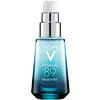What's inside
What's inside
 Key Ingredients
Key Ingredients

 Benefits
Benefits

 Concerns
Concerns

 Ingredients Side-by-side
Ingredients Side-by-side

Water
Skin ConditioningCoco-Caprylate
EmollientTitanium Dioxide
Cosmetic ColorantDicaprylyl Carbonate
EmollientCocoglycerides
EmollientButyrospermum Parkii Butter
Skin ConditioningCeteareth-6 Olivate
EmulsifyingDiethylhexyl Succinate
EmollientLauryl Glucoside
CleansingPolyglyceryl-2 Dipolyhydroxystearate
Skin ConditioningKaolin
AbrasiveBentonite
AbsorbentHydroxypropyl Starch Phosphate
Triheptanoin
Skin ConditioningCurcumin
AntioxidantSodium Hyaluronate
HumectantSodium Ascorbyl Phosphate
AntioxidantTetrahexyldecyl Ascorbate
AntioxidantNiacinamide
SmoothingGlycerin
HumectantMicrocrystalline Cellulose
AbsorbentPanthenol
Skin ConditioningSorbitol
HumectantMica
Cosmetic ColorantTocopheryl Acetate
AntioxidantXanthan Gum
EmulsifyingJojoba Esters
EmollientSodium Phytate
Alumina
AbrasiveAsparagopsis Armata Extract
Skin ProtectingCaffeine
Skin ConditioningSilica
AbrasiveAscophyllum Nodosum Extract
Skin ConditioningCaprylic/Capric Triglyceride
MaskingCitrus Grandis Peel Oil
MaskingCitrus Reticulata Peel Oil
MaskingCitrus Aurantium Dulcis Peel Oil
MaskingLavandula Angustifolia Oil
MaskingCitrus Reticulata Leaf Oil
MaskingBenzyl Acetate
MaskingGeraniol
PerfumingLavandula Hybrida Oil
EmollientCitral
PerfumingLinalool
PerfumingDecanal
MaskingCitrus Aurantium Flower Oil
PerfumingPotassium Sorbate
PreservativeTin Oxide
AbrasiveIron Oxides
C13-16 Isoparaffin
SolventEthylhexylglycerin
Skin ConditioningPhenoxyethanol
PreservativeWater, Coco-Caprylate, Titanium Dioxide, Dicaprylyl Carbonate, Cocoglycerides, Butyrospermum Parkii Butter, Ceteareth-6 Olivate, Diethylhexyl Succinate, Lauryl Glucoside, Polyglyceryl-2 Dipolyhydroxystearate, Kaolin, Bentonite, Hydroxypropyl Starch Phosphate, Triheptanoin, Curcumin, Sodium Hyaluronate, Sodium Ascorbyl Phosphate, Tetrahexyldecyl Ascorbate, Niacinamide, Glycerin, Microcrystalline Cellulose, Panthenol, Sorbitol, Mica, Tocopheryl Acetate, Xanthan Gum, Jojoba Esters, Sodium Phytate, Alumina, Asparagopsis Armata Extract, Caffeine, Silica, Ascophyllum Nodosum Extract, Caprylic/Capric Triglyceride, Citrus Grandis Peel Oil, Citrus Reticulata Peel Oil, Citrus Aurantium Dulcis Peel Oil, Lavandula Angustifolia Oil, Citrus Reticulata Leaf Oil, Benzyl Acetate, Geraniol, Lavandula Hybrida Oil, Citral, Linalool, Decanal, Citrus Aurantium Flower Oil, Potassium Sorbate, Tin Oxide, Iron Oxides, C13-16 Isoparaffin, Ethylhexylglycerin, Phenoxyethanol
 Reviews
Reviews

Ingredients Explained
These ingredients are found in both products.
Ingredients higher up in an ingredient list are typically present in a larger amount.
This ingredient is also known as shea butter. It is an effective skin hydrator and emollient.
Emollients help soothe and soften your skin. It does this by creating a protective film on your skin. This barrier helps trap moisture and keeps your skin hydrated. Emollients may be effective at treating dry or itchy skin.
Shea butter is rich in antioxidants. Antioxidants help fight free-radicals, or molecules that may harm the body. It is also full of fatty acids including stearic acid and linoleic acid. These acids help replenish the skin and keep skin moisturized.
While Shea Butter has an SPF rating of about 3-4, it is not a sunscreen replacement.
Shea butter may not be fungal acne safe. We recommend speaking with a professional if you have any concerns.
Learn more about Butyrospermum Parkii ButterCaffeine is most associated with coffee, tea, and cacao. In skincare, it helps with calming inflammation and is rich in antioxidants.
While caffeine is used to treat cellulite and and dark circles, further studies are needed to prove this. It has been believed to help with these skin conditions due to its ability to dilate blood vessels and increase blood flow.
Some studies are looking into caffeine's ability to protect against UV rays.
Learn more about CaffeineGlycerin is already naturally found in your skin. It helps moisturize and protect your skin.
A study from 2016 found glycerin to be more effective as a humectant than AHAs and hyaluronic acid.
As a humectant, it helps the skin stay hydrated by pulling moisture to your skin. The low molecular weight of glycerin allows it to pull moisture into the deeper layers of your skin.
Hydrated skin improves your skin barrier; Your skin barrier helps protect against irritants and bacteria.
Glycerin has also been found to have antimicrobial and antiviral properties. Due to these properties, glycerin is often used in wound and burn treatments.
In cosmetics, glycerin is usually derived from plants such as soybean or palm. However, it can also be sourced from animals, such as tallow or animal fat.
This ingredient is organic, colorless, odorless, and non-toxic.
Glycerin is the name for this ingredient in American English. British English uses Glycerol/Glycerine.
Learn more about GlycerinPhenoxyethanol is a preservative that has germicide, antimicrobial, and aromatic properties. Studies show that phenoxyethanol can prevent microbial growth. By itself, it has a scent that is similar to that of a rose.
It's often used in formulations along with Caprylyl Glycol to preserve the shelf life of products.
Sodium Hyaluronate is hyaluronic acid's salt form. It is commonly derived from the sodium salt of hyaluronic acid.
Like hyaluronic acid, it is great at holding water and acts as a humectant. This makes it a great skin hydrating ingredient.
Sodium Hyaluronate is naturally occurring in our bodies and is mostly found in eye fluid and joints.
These are some other common types of Hyaluronic Acid:
Learn more about Sodium HyaluronateWater. It's the most common cosmetic ingredient of all. You'll usually see it at the top of ingredient lists, meaning that it makes up the largest part of the product.
So why is it so popular? Water most often acts as a solvent - this means that it helps dissolve other ingredients into the formulation.
You'll also recognize water as that liquid we all need to stay alive. If you see this, drink a glass of water. Stay hydrated!
Learn more about Water